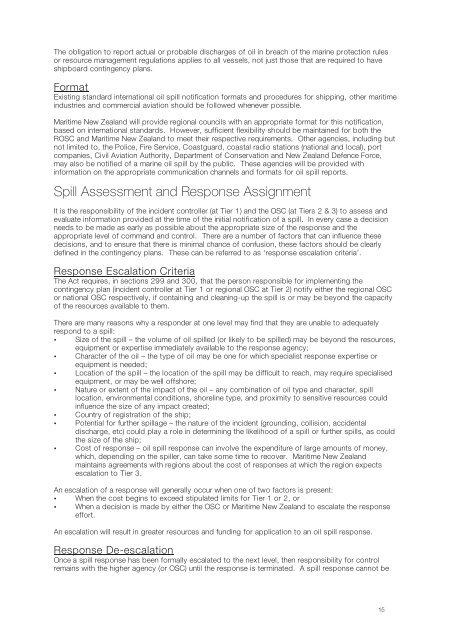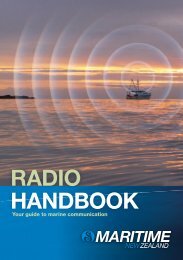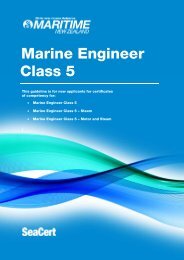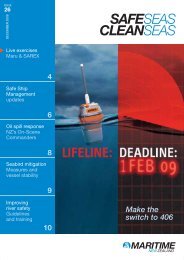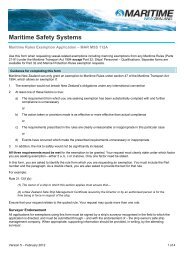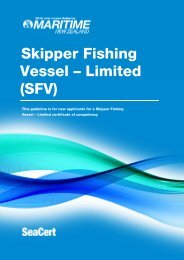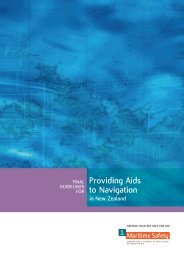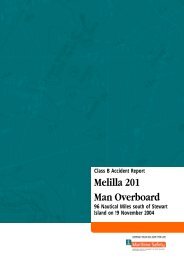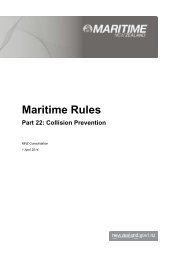New Zealand oil spill response strategy - Maritime New Zealand
New Zealand oil spill response strategy - Maritime New Zealand
New Zealand oil spill response strategy - Maritime New Zealand
You also want an ePaper? Increase the reach of your titles
YUMPU automatically turns print PDFs into web optimized ePapers that Google loves.
The obligation to report actual or probable discharges of <strong>oil</strong> in breach of the marine protection rules<br />
or resource management regulations applies to all vessels, not just those that are required to have<br />
shipboard contingency plans.<br />
Format<br />
Existing standard international <strong>oil</strong> <strong>spill</strong> notification formats and procedures for shipping, other maritime<br />
industries and commercial aviation should be followed whenever possible.<br />
<strong>Maritime</strong> <strong>New</strong> <strong>Zealand</strong> will provide regional councils with an appropriate format for this notification,<br />
based on international standards. However, sufficient flexibility should be maintained for both the<br />
ROSC and <strong>Maritime</strong> <strong>New</strong> <strong>Zealand</strong> to meet their respective requirements. Other agencies, including but<br />
not limited to, the Police, Fire Service, Coastguard, coastal radio stations (national and local), port<br />
companies, Civil Aviation Authority, Department of Conservation and <strong>New</strong> <strong>Zealand</strong> Defence Force,<br />
may also be notified of a marine <strong>oil</strong> <strong>spill</strong> by the public. These agencies will be provided with<br />
information on the appropriate communication channels and formats for <strong>oil</strong> <strong>spill</strong> reports.<br />
Spill Assessment and Response Assignment<br />
It is the responsibility of the incident controller (at Tier 1) and the OSC (at Tiers 2 & 3) to assess and<br />
evaluate information provided at the time of the initial notification of a <strong>spill</strong>. In every case a decision<br />
needs to be made as early as possible about the appropriate size of the <strong>response</strong> and the<br />
appropriate level of command and control. There are a number of factors that can influence these<br />
decisions, and to ensure that there is minimal chance of confusion, these factors should be clearly<br />
defined in the contingency plans. These can be referred to as ‘<strong>response</strong> escalation criteria’.<br />
Response Escalation Criteria<br />
The Act requires, in sections 299 and 300, that the person responsible for implementing the<br />
contingency plan (incident controller at Tier 1 or regional OSC at Tier 2) notify either the regional OSC<br />
or national OSC respectively, if containing and cleaning-up the <strong>spill</strong> is or may be beyond the capacity<br />
of the resources available to them.<br />
There are many reasons why a responder at one level may find that they are unable to adequately<br />
respond to a <strong>spill</strong>:<br />
• Size of the <strong>spill</strong> – the volume of <strong>oil</strong> <strong>spill</strong>ed (or likely to be <strong>spill</strong>ed) may be beyond the resources,<br />
equipment or expertise immediately available to the <strong>response</strong> agency;<br />
• Character of the <strong>oil</strong> – the type of <strong>oil</strong> may be one for which specialist <strong>response</strong> expertise or<br />
equipment is needed;<br />
• Location of the <strong>spill</strong> – the location of the <strong>spill</strong> may be difficult to reach, may require specialised<br />
equipment, or may be well offshore;<br />
• Nature or extent of the impact of the <strong>oil</strong> – any combination of <strong>oil</strong> type and character, <strong>spill</strong><br />
location, environmental conditions, shoreline type, and proximity to sensitive resources could<br />
influence the size of any impact created;<br />
• Country of registration of the ship;<br />
• Potential for further <strong>spill</strong>age – the nature of the incident (grounding, collision, accidental<br />
discharge, etc) could play a role in determining the likelihood of a <strong>spill</strong> or further <strong>spill</strong>s, as could<br />
the size of the ship;<br />
• Cost of <strong>response</strong> – <strong>oil</strong> <strong>spill</strong> <strong>response</strong> can involve the expenditure of large amounts of money,<br />
which, depending on the <strong>spill</strong>er, can take some time to recover. <strong>Maritime</strong> <strong>New</strong> <strong>Zealand</strong><br />
maintains agreements with regions about the cost of <strong>response</strong>s at which the region expects<br />
escalation to Tier 3.<br />
An escalation of a <strong>response</strong> will generally occur when one of two factors is present:<br />
• When the cost begins to exceed stipulated limits for Tier 1 or 2, or<br />
• When a decision is made by either the OSC or <strong>Maritime</strong> <strong>New</strong> <strong>Zealand</strong> to escalate the <strong>response</strong><br />
effort.<br />
An escalation will result in greater resources and funding for application to an <strong>oil</strong> <strong>spill</strong> <strong>response</strong>.<br />
Response De-escalation<br />
Once a <strong>spill</strong> <strong>response</strong> has been formally escalated to the next level, then responsibility for control<br />
remains with the higher agency (or OSC) until the <strong>response</strong> is terminated. A <strong>spill</strong> <strong>response</strong> cannot be<br />
15


